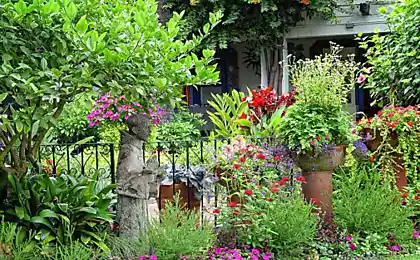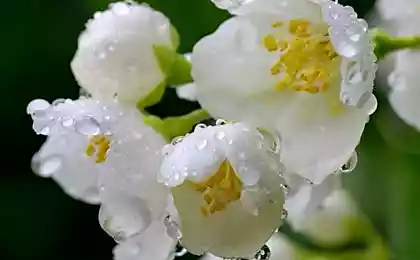516
The cultivation of calibrachoa: the secrets and subtleties
Seeing , calibrachoa in the photo, it is possible to confuse it with the usual petunias. Yes, their flowers are similar, and it is not strange, as was originally the most decorative look, calibrachoa is derived from the genus Petunia. By changing the number of chromosomes of the Japanese breeders have made significant changes to the appearance of Petunia: calibrachoa chromosome 18, and petunias are only 14.
In other words, despite the similarities, calibrachoa and Petunia – are quite different, though related to each other, plants.
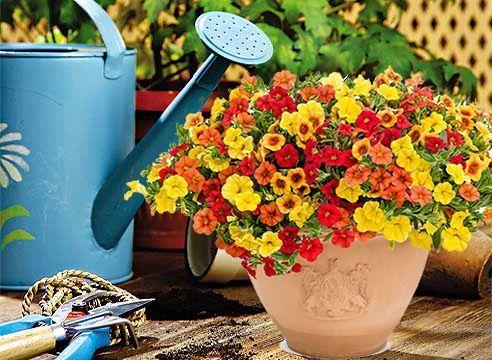
Flowers, calibrachoa do not exceed a diameter of 2.5 - 3 cm, but their size is completely kompensiruet. No wonder the most famous artesania, calibrachoa called Million Bells (million bells). This name completely conveys the character of the plant in hanging baskets grows long lashes 0.5-1 m with many colors.
The cultivation of calibrachoa Million Bells Million Bells Cartoneria includes 18 varieties with purple, pink, mauve, red, cherry, crimson, lemon yellow, dark yellow color.
Initially, the flowers are calibrachoa was only purple is the native color plants. Later, when it attracted the interest of breeders were bred new varieties with white, red, pink, blue, yellow, brown colors.
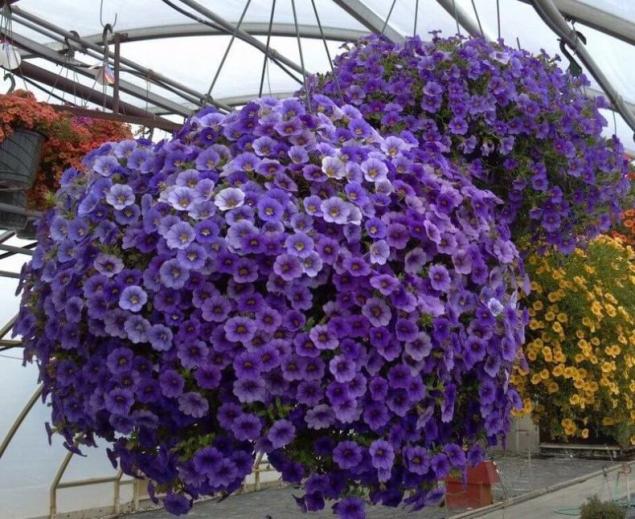
A notable feature of calibrachoa is that its flower is always a "throat" that is different in color from the rest of the Corolla. "Throat" can be yellow or brownish.
Flowers, calibrachoa the imagination. Usually flower calibrachoa simple, similar to pecuniary bell. Currently, however, it is possible to meet and the double varieties, which are a little lose in the abundance of flowering, calibrachoa-simpleton.
Than calibrachoa different from petunias? Sometimes, calibrachoa sold in garden centers under the name "Petunia", "Petunia hanging plant" or something like that. Blame it on the producers makes no sense. Most likely, these titles are aimed at consumers who know nothing about calibrachoa, but petunias are already aware.

If you are faced with this situation, the eye has not seen, calibrachoa, but you would think that selling "Petunia" – this is it, then do the following:
— estimate the size of the flower – it was already mentioned above that calibrachoa it is small – not more than 3 cm, However, this "evidence" is indirect, because minitune (Shock Wave), which is a real Petunia, the flower is not too conspicuous size;
— note the "throat" the pharynx at the base of the Corolla. He always dramatically different in color usually it is bright yellow, like the feathers of a chicken;
consider the sheets – this is perhaps the most vivid and direct contrast, calibrachoa from Petunia. Leaves, calibrachoa very small (width not more than 1 cm in length and 3-4 cm) long, covered with sparse, short hairs. The same fuzz on the stems;
— inspect the stem. Unlike Petunia, stem, calibrachoa more dense, prone to lignification. The Petunia stem flexible, herbaceous, calibrachoa – in appearance more like a stem of a Bush.
Calibrachoa: grow and careFor successful cultivation, calibrachoa need a lot of light and heat. Especially good for this plant a Sunny balcony or terrace South or South-East orientation. However, without the searing heat! Overly aggressive midday sun, calibrachoa may burn – pritenyayut it in this watch.
Does not accept the the plant and gusty winds, which can easily deconstruct and even to break up stems and flowers.
Open balconies on the upper floors of tall buildings is not the best place for calibrachoa. To grow this miracle better protected from the wind.
Calibrachoa, planted in hanging baskets, seabalcony boxes, high vases. 1 the plant requires at least 2-3 litres of earth. The soil should be light and loose, preferably with lots of baking powder. The soil reaction is neutral or slightly acidic.
The cultivation of calibrachoa in hanging pots, Calibrachoa – basket plant, manifesting itself in all its glory in hanging pots, high pots and seabalcony boxes.
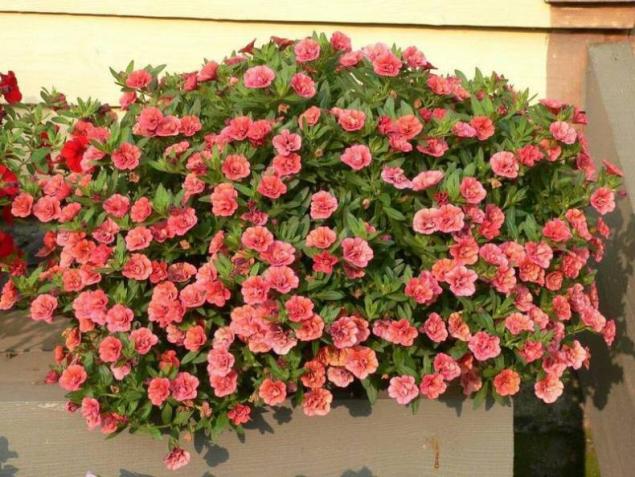
The hydrogel in the soil is not added. This plant is much smaller than the Petunia, needs moist soil. On the contrary, the constant moisture is invalid.
Calibrachoa, very easy to pour, causing the delicate roots rot quickly and the plant dies.
Conclusion: you need to water it less frequently than Petunia.
Butregular spraying , calibrachoa just love it! In particularly hot days, do not skimp on the moisture and spray the plant 3-4 times a day (only when the sun is not shining directly on the bushes).
The whole period of vegetation care, calibrachoa suggests enhanced "feeding". Be sure to make fertilizer every week. In the seedling period of use the compounds of nitrogen, and during budding and flowering – with a high content of phosphorus (especially!) and potassium.
In principle, feed, calibrachoa need as well as to fertilize Petunia.
To maintain a constant flowering and appearance of bushes, dead flowers cut off, so they are not tied seeds.
In mid-summer, when flowering, calibrachoa weakens, you can cut the stems half-length. This will be a great stimulation for better branching plants and bookmarks of young flower buds in large quantities.
Care, calibrachoa, Calibrachoa – more drought resistant plant than Petunia, but need regular fertilizing it as high.

Reproduction of calibrachoa, calibrachoa Propagated using rooted cuttings, vegetative. This does not mean that the plant does not make seeds, it does it willingly, but... the Problem is that calibrachoa from seed often grows similar to its "parents". In other words, in its development, it "rolls" to the "wild" variants, calibrachoa of which were created by the mother plant are hybrids.
Calibrachoa, grown from seed may bloom poorly, and the flowers can be absolutely the wrong color, smaller size, etc. Although you may be lucky – calibrachoa from seed will repeat the mother plant, but it will rather be the exception to the rule.
A win-win option is the reproduction of calibrachoa cuttings. To do this in late summer or early autumn, cut from the mother plants apical cuttings 4-5 cm long. Lower leaves tear off and the bare part of the stem planted in a light moist soil.
In order for the cuttings, calibrachoa rooted, they are placed in the “hothouse”. The easiest way to cover the planted cutting with a plastic Cup and to lift it every day for a few minutes for ventilation.
In conditions of high humidity “greenhouse”, calibrachoa cuttings quickly take root. After this "hothouse" can be removed and care for the cuttings, as for conventional plants. They are totally unpretentious and without loss survive the winter. In spring already grown bushes again cut apical cuttings and rooting again – they are grown and blooming, calibrachoa.

Rooted cuttings, calibrachoa For rooted cuttings, calibrachoa winter should be cared for just like ordinary potted flowers.
Similarly, in the home, keep the mother plant will be much harder. It will have to be kept cool and moist conditions is perfect – on the bright glazed balcony, where the temperature does not fall below 2-3°C. If you manage to keep calibrachoa, winter, spring he, again, cut off the stem and root.published
P. S. And remember, only by changing their consumption — together we change the world! ©
Source: vk.com/vo_sadu_li?w=wall-88305316_71220
In other words, despite the similarities, calibrachoa and Petunia – are quite different, though related to each other, plants.

Flowers, calibrachoa do not exceed a diameter of 2.5 - 3 cm, but their size is completely kompensiruet. No wonder the most famous artesania, calibrachoa called Million Bells (million bells). This name completely conveys the character of the plant in hanging baskets grows long lashes 0.5-1 m with many colors.
The cultivation of calibrachoa Million Bells Million Bells Cartoneria includes 18 varieties with purple, pink, mauve, red, cherry, crimson, lemon yellow, dark yellow color.
Initially, the flowers are calibrachoa was only purple is the native color plants. Later, when it attracted the interest of breeders were bred new varieties with white, red, pink, blue, yellow, brown colors.

A notable feature of calibrachoa is that its flower is always a "throat" that is different in color from the rest of the Corolla. "Throat" can be yellow or brownish.
Flowers, calibrachoa the imagination. Usually flower calibrachoa simple, similar to pecuniary bell. Currently, however, it is possible to meet and the double varieties, which are a little lose in the abundance of flowering, calibrachoa-simpleton.
Than calibrachoa different from petunias? Sometimes, calibrachoa sold in garden centers under the name "Petunia", "Petunia hanging plant" or something like that. Blame it on the producers makes no sense. Most likely, these titles are aimed at consumers who know nothing about calibrachoa, but petunias are already aware.

If you are faced with this situation, the eye has not seen, calibrachoa, but you would think that selling "Petunia" – this is it, then do the following:
— estimate the size of the flower – it was already mentioned above that calibrachoa it is small – not more than 3 cm, However, this "evidence" is indirect, because minitune (Shock Wave), which is a real Petunia, the flower is not too conspicuous size;
— note the "throat" the pharynx at the base of the Corolla. He always dramatically different in color usually it is bright yellow, like the feathers of a chicken;
consider the sheets – this is perhaps the most vivid and direct contrast, calibrachoa from Petunia. Leaves, calibrachoa very small (width not more than 1 cm in length and 3-4 cm) long, covered with sparse, short hairs. The same fuzz on the stems;
— inspect the stem. Unlike Petunia, stem, calibrachoa more dense, prone to lignification. The Petunia stem flexible, herbaceous, calibrachoa – in appearance more like a stem of a Bush.
Calibrachoa: grow and careFor successful cultivation, calibrachoa need a lot of light and heat. Especially good for this plant a Sunny balcony or terrace South or South-East orientation. However, without the searing heat! Overly aggressive midday sun, calibrachoa may burn – pritenyayut it in this watch.
Does not accept the the plant and gusty winds, which can easily deconstruct and even to break up stems and flowers.
Open balconies on the upper floors of tall buildings is not the best place for calibrachoa. To grow this miracle better protected from the wind.
Calibrachoa, planted in hanging baskets, seabalcony boxes, high vases. 1 the plant requires at least 2-3 litres of earth. The soil should be light and loose, preferably with lots of baking powder. The soil reaction is neutral or slightly acidic.
The cultivation of calibrachoa in hanging pots, Calibrachoa – basket plant, manifesting itself in all its glory in hanging pots, high pots and seabalcony boxes.

The hydrogel in the soil is not added. This plant is much smaller than the Petunia, needs moist soil. On the contrary, the constant moisture is invalid.
Calibrachoa, very easy to pour, causing the delicate roots rot quickly and the plant dies.
Conclusion: you need to water it less frequently than Petunia.
Butregular spraying , calibrachoa just love it! In particularly hot days, do not skimp on the moisture and spray the plant 3-4 times a day (only when the sun is not shining directly on the bushes).
The whole period of vegetation care, calibrachoa suggests enhanced "feeding". Be sure to make fertilizer every week. In the seedling period of use the compounds of nitrogen, and during budding and flowering – with a high content of phosphorus (especially!) and potassium.
In principle, feed, calibrachoa need as well as to fertilize Petunia.
To maintain a constant flowering and appearance of bushes, dead flowers cut off, so they are not tied seeds.
In mid-summer, when flowering, calibrachoa weakens, you can cut the stems half-length. This will be a great stimulation for better branching plants and bookmarks of young flower buds in large quantities.
Care, calibrachoa, Calibrachoa – more drought resistant plant than Petunia, but need regular fertilizing it as high.

Reproduction of calibrachoa, calibrachoa Propagated using rooted cuttings, vegetative. This does not mean that the plant does not make seeds, it does it willingly, but... the Problem is that calibrachoa from seed often grows similar to its "parents". In other words, in its development, it "rolls" to the "wild" variants, calibrachoa of which were created by the mother plant are hybrids.
Calibrachoa, grown from seed may bloom poorly, and the flowers can be absolutely the wrong color, smaller size, etc. Although you may be lucky – calibrachoa from seed will repeat the mother plant, but it will rather be the exception to the rule.
A win-win option is the reproduction of calibrachoa cuttings. To do this in late summer or early autumn, cut from the mother plants apical cuttings 4-5 cm long. Lower leaves tear off and the bare part of the stem planted in a light moist soil.
In order for the cuttings, calibrachoa rooted, they are placed in the “hothouse”. The easiest way to cover the planted cutting with a plastic Cup and to lift it every day for a few minutes for ventilation.
In conditions of high humidity “greenhouse”, calibrachoa cuttings quickly take root. After this "hothouse" can be removed and care for the cuttings, as for conventional plants. They are totally unpretentious and without loss survive the winter. In spring already grown bushes again cut apical cuttings and rooting again – they are grown and blooming, calibrachoa.

Rooted cuttings, calibrachoa For rooted cuttings, calibrachoa winter should be cared for just like ordinary potted flowers.
Similarly, in the home, keep the mother plant will be much harder. It will have to be kept cool and moist conditions is perfect – on the bright glazed balcony, where the temperature does not fall below 2-3°C. If you manage to keep calibrachoa, winter, spring he, again, cut off the stem and root.published
P. S. And remember, only by changing their consumption — together we change the world! ©
Source: vk.com/vo_sadu_li?w=wall-88305316_71220
Air connection of electricity in the country
Useful barley flour — essential for baking cakes and breads!






